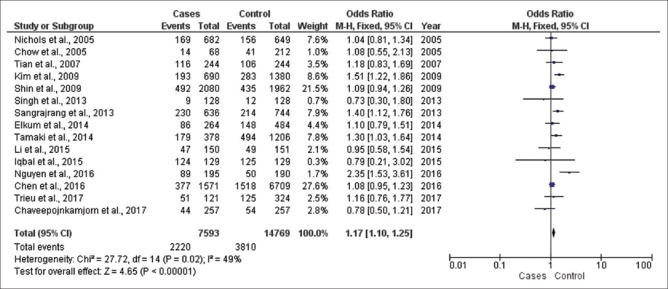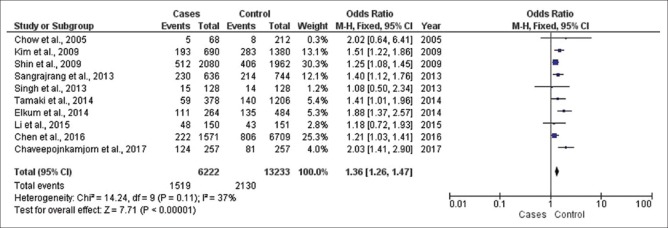Abstract
Background:
The association of overweight and obesity with breast cancer risk in premenopausal women and in different ethnicities remains in debate, especially among Asian women. The aim of this systematic review and meta-analysis was to determine the association of overweight and obesity with breast cancer during premenopausal period in Asian women.
Methods:
We performed a meta-analysis of research articles on the association of overweight and obesity with breast cancer during premenopausal period in Asian women published from January 2000 to July 2018 in article databases of EBSCO, PubMed, and ProQuest. Pooled odds ratios (ORs) were calculated by fixed and random-effect models. Publication bias was visually evaluated using funnel plots, and then statistically assessed using Egger's and Begg's tests. Review Manager 5.3 (RevMan 5.3) and Stata version 14.2 (Stata Corporation) were used to process the data. We reviewed 886 articles.
Results:
We found 15 studies conducted systematic review continued by meta-analysis of relevant data with 22,362 patients. There was significant association of obesity [OR = 1.36 (95% confidence interval (CI) 1.26–1.47, P < 0.00001)] and overweight [OR = 1.17 (95% CI 1.10–1.25, P < 0.00001)] with breast cancer during premenopausal period in Asian women. In this study, there was no significant publication bias for studies included in overweight and obesity with breast cancer during premenopausal in Asian women.
Conclusions:
This study suggested association of overweight and obesity with breast cancer during premenopausal period in Asian women.
Keywords: Breast neoplasms, obesity, overweight, premenopause
Introduction
Breast cancer is the most frequent type of cancer found in women worldwide. It is estimated that 11.6% or 2,088,849 new cases and 6.6% or 626,679 cases are predicted to end with mortality with this cancer.[1] The etiology is multifactorial – one of the risk factors confirmed is high body mass index (BMI).[2,3,4]
A study, conducted by Women's Health Initiative Clinical Trial Participants on baseline BMI (kg/m2) with a sample size of 67,142 respondents in the United States, confirmed that the incidence of breast cancer in patients with overweight was higher in White women with 82.7% and in obese White women it was 78.7%. In overweight Black women it was 8.9% and it was 13.2% for obese Black women. Furthermore, interestingly, it has been found that breast cancer in Asians who were overweight and obese was 2.1% and 1.8%, respectively.[5,6]
High BMI potentially increases the risk of breast cancer as the synthesis of estrogen in body fat correlates with the proliferation of breast tissue.[7] Adipose tissue has an essential role in the body by storing excess calories as fat and establishing endocrine control in other body sites. Furthermore, central distribution increase of body mass could produce a higher risk of breast cancer in women, particularly if the patient has family history of breast cancer.[7]
The correlation of high BMI with the increase in breast cancer risk in postmenopausal women showed constant evidence.[2,3,4] However, the correlation is still controversial in premenopausal women.[8,9] The association of BMI with breast cancer risk in premenopausal women from various ethnicities remains in debate, especially among Asian women.[3,10,11] Several studies in Asian premenopausal women from Japan, China, and Taiwan have suggested no association between BMI and breast cancer risk.[3,10,12,13,14] Yet, some studies in India, Thailand, Saudi Arabia, and Vietnam found significant correlation of BMI with breast cancer risk.[15,16,17,18]
Therefore, this study was held to determine the association of overweight and obesity with breast cancer during premenopausal period in Asian women through a meta-analysis study to draw a stronger strength of conclusion.
Methods
Study design and research sample
This research was quantitative which was conducted using meta-analysis study design. The meta-analysis followed PRISMA (Preferred Reporting Items for Systematic Reviews and Meta-Analysis) statement.[19] Meta-analysis was held to determine the association of overweight and obesity with breast cancer during premenopausal period in Asian women. The research samples included published research articles from January 2000 to July 2018 in article databases of EBSCO, PubMed, and ProQuest.
Operational definitions
The variables of this study were divided into two independent variables, that is, overweight (BMI 23.0–24.9 kg/m2) and obese (BMI ≥25 kg/m2),[20] and a dependent variable, that is, breast cancer.
Research procedure
This study was held by collecting data by identification of published research articles on association of overweight and obesity with breast cancer during premenopausal period in Asian women in article databases of EBSCO, PubMed, and ProQuest [Figure 1].
Figure 1.
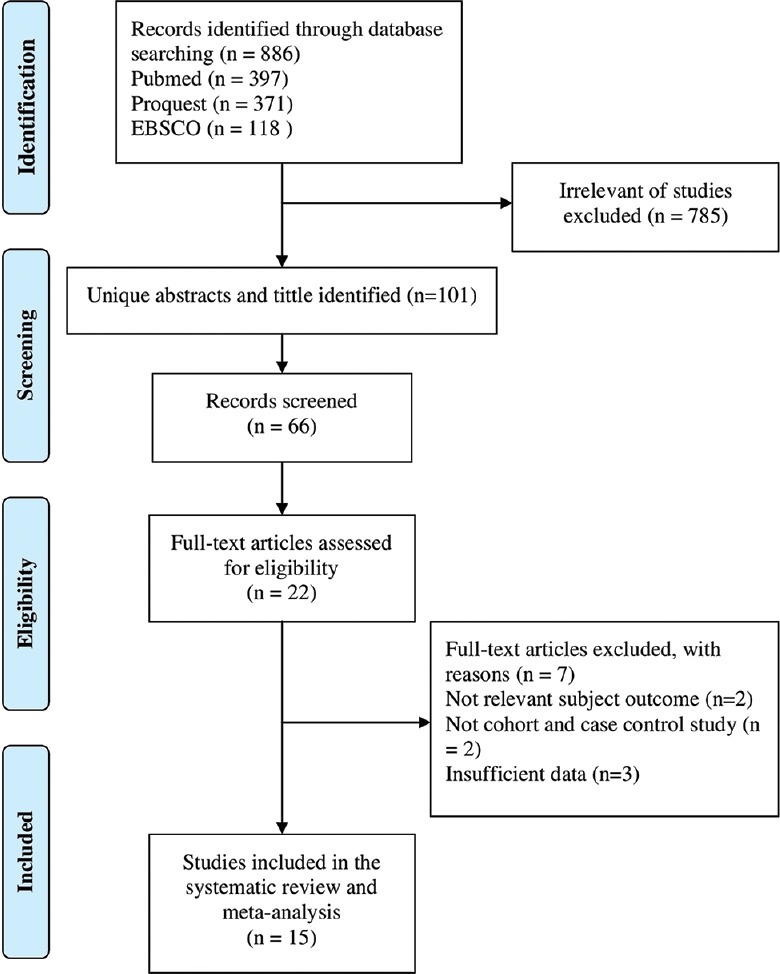
Flow diagram research procedure
Identification process of the 886 articles was conducted by reviewing the article titles, and then continued by reviewing the abstract and their full text. The exclusion criteria were as follows: (a) unrelevant to subjects of the study, (b) the study methods were neither cohort nor case–control study, and (c) the data provided in the study results’ section were not proper for extraction.
Data collection technique
Data collection was held by online search. The search was limited to English articles. The date of publication was limited from January 2000 to July 2018. The article type was limited to research articles. The research subject was limited to human subject research. The abstract of articles with relevant titles were assessed, while the irrelevant ones were excluded. Furthermore, the articles included were reviewed in full-text form; after that, irrelevant full-text articles were excluded. The inclusion criteria of this study sample were research on overweight and obesity for breast cancer risk with case–control and cohort study methods. The exclusion criteria were either the article was not available in full-text form or the criteria were unsatisfyingly fulfilled, or if the information provided was not proper for data extraction. These following data were obtained from the articles: name of first author and publication year, region of study location, study type, exposure, and total samples.
Two independent investigators carefully extracted information from all articles included in accordance with standardized protocol. Disagreements were resolved by three other investigators. Quality assessment was conducted by Newcastle–Ottawa Quality Assessment Scale (NOS). Articles with a total score of 0–3, 4–6, and 7–9 points were specified as poor, moderate, and high quality, respectively.[21]
Data analysis
The analysis was performed to get the pooled odds ratio (OR) as combined OR from the articles. OR with corresponding 95% confidence intervals (CIs) were utilized to pool the results. Significant heterogeneity was indicated by I2 > 50% as these tests presented minimal statistical power on cases with limited numbers of articles and sample sizes. A random-effect model was used when observing significant heterogeneity; otherwise, a fixed-effect model was utilized. Review Manager 5.3 (RevMan 5.3) was used to analyze the data.
Publication bias was visually evaluated using funnel plots and statistically assessed through Egger's and Begg's tests. Meta-analysis was carried out in Stata version 14.2 (StataCorp, College Station, Texas, USA. A two-tailed P value <0.05 was considered statistically significant.
Results
The selection of studies was conducted to obtain 15 studies related to the association of overweight and obesity with breast cancer during premenopausal period in Asian women [Table 1].[1,15,16,17,18,22,23,24,25,26,27,28,29,30,31]
Table 1.
Systematic review association of overweight and obesity with breast cancer during premenopausal period in Asia
| First author, year | Region | Type of study | Exposure | No. of sample | NOS | |
|---|---|---|---|---|---|---|
| Cases | Control | |||||
| Nichols et al.[22] | Vietnam, China | Case-control | Overweight | 682 | 649 | 7 |
| Chow et al.[13] | Hong Kong | Case-control | Overweight | 68 | 212 | 6 |
| Obesity | ||||||
| Tian et al.[23] | Taiwan | Case-control | Overweight | 244 | 244 | 7 |
| Kim et al.[24] | South Korea | Case-control | Overweight | 690 | 1380 | 7 |
| Obesity | ||||||
| Shin et al.[25] | China | Case-control | Overweight | 2080 | 1962 | 8 |
| Obesity | ||||||
| Singh et al.[15] | India | Case-control | Overweight | 128 | 128 | 6 |
| Obesity | ||||||
| Sangrajrang et al.[16] | Thailand | Case-control | Overweight | 636 | 744 | 7 |
| Obesity | ||||||
| Elkum et al.[17] | Saudi Arabia | Case-control | Overweight | 264 | 484 | 7 |
| Obesity | ||||||
| Tamaki et al.[26] | Japan | Case-control | Overweight | 378 | 1206 | 8 |
| Obesity | ||||||
| Li et al.[27] | China | Case-control | Overweight | 150 | 151 | 7 |
| Obesity | ||||||
| Iqbal et al.[28] | Bangladesh | Case-control | Overweight | 129 | 129 | 6 |
| Nguyen et al.[18] | Vietnam | Case-control | Overweight | 195 | 190 | 7 |
| Chen et al.[29] | Taiwan | Cohort | Overweight | 1571 | 6709 | 8 |
| Obesity | ||||||
| Trieu et al.[30] | Vietnam | Case-control | Overweight | 121 | 324 | 7 |
| Chaveepojnkamjorn et al.[31] | Thailand | Case-control | Overweight | 257 | 257 | 7 |
| Obesity | ||||||
| No. of samples | 7,593 | 14,769 | ||||
NOS: Newcastle-Ottawa Quality Assessment Scale
Meta-analysis study was performed to determine the association of overweight with breast cancer during premenopausal period in Asian women [Figure 2]. Figure 2 shows meta-analysis of association of overweight with breast cancer during premenopausal period in Asian women with OR = 1.17 (95% CI 1.10–1.25, P < 0.00001). Heterogeneity in studies for overweight with breast cancer during premenopausal period in Asian women (Pheterogeneity = 0.02; I2 = 49%) showed a variation in homogeneous research on the occurrence of breast cancer. Funnel plots to identify publication bias among studies on the association of overweight with breast cancer during premenopausal period in Asian women are shown in Figure 3.
Figure 2.
Forest plots’ association of overweight with breast cancer during premenopausal period in Asia
Figure 3.
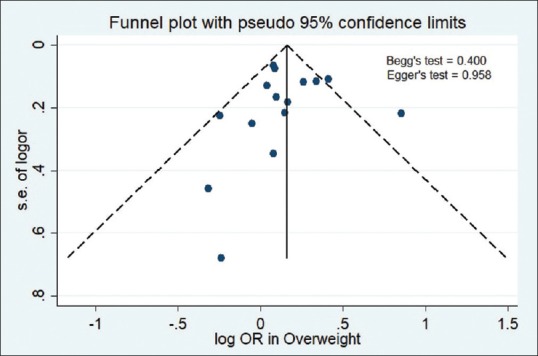
Funnel plots’ association of overweight with breast cancer during premenopausal period in Asia
In Figure 3, we found that there was no significant publication bias for the studies on association of overweight with breast cancer during premenopausal in Asian women included in Egger's test (P = 0.958) and Begg's test (P = 0.400).
This meta-analysis study was also conducted to determine the association of obesity with breast cancer during premenopausal period in Asian women [Figure 4]. Figure 2 shows meta-analysis of association of obesity with breast cancer during premenopausal period in Asian women with OR = 1.36 (95% CI 1.26–1.47, P < 0.00001). Heterogeneity in studies for obesity with breast cancer during premenopausal period in Asian women (Pheterogeneity = 0.11; I2 = 37%) showed a variation in homogeneous research on the occurrence of breast cancer. Funnel plots to identify publication bias among studies on the association of obesity with breast cancer during premenopausal period in Asian women are shown in Figure 5.
Figure 4.
Forest plots’ association of obesity with breast cancer during premenopausal period in Asia
Figure 5.
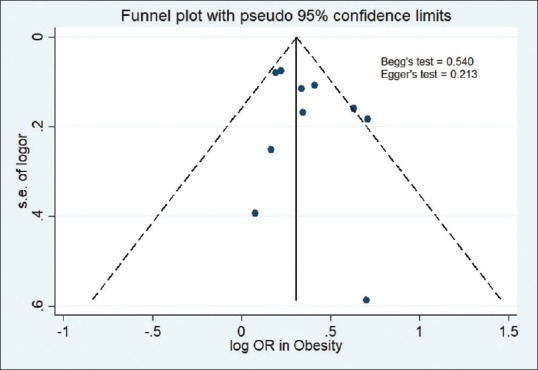
Funnel plots’ association of obesity with breast cancer during premenopausal period in Asia
In Figure 5, it can be seen that there was no significant publication bias for the studies on obesity with breast cancer during premenopausal in Asian women included in Egger's test (P = 0.213) and Begg's test (P = 0.540).
Discussion
The results of this meta-analysis revealed that overweight and obesity during premenopausal period can increase the risk of breast cancer in Asian women. Obesity had higher OR for breast cancer risk [OR = 1.36 (95% CI 1.26–1.47)] than overweight [OR = 1.17 (95% CI 1.10–1.25)]. The higher the level of BMI, the higher the risk for incident breast cancer in women during premenopausal period.
Recent trends have shown an increase in breast cancer incidence, not only in postmenopausal but also in premenopausal women nowadays. A potential explanation for this increase is lifestyle change as a result of rapid economic improvement. In the past two decades, the levels of physical activity have reduced and food patterns have changed, leading to an increase in average population BMI.[32] Previous studies, which collected data on 42 developing countries in Asia, the Middle East, Africa, and Latin America, found that the growth of overweight and obesity was 0.7% annually, and there was an estimated 19% of rural women and 37.2% of urban women who were overweight or obese.[33,34]
Breast cancer is characterized by high prevalence in overweight and obese women, high percentage of body fat and central obesity, and unbalanced diet. Considering that in recent years the prevalence of obesity has increased significantly in both developed and developing countries, it is crucial to develop strategies to prevent this condition and its associated breast cancer risk factors.[32,35]
There was significant correlation between overweight and breast cancer during premenopausal and postmenopausal periods in Southeast Asia [OR = 1.61 (95% CI 1.43–1.80)].[4] A number of studies have shown an increase in breast cancer risk in premenopause and a positive correlation between obesity and breast cancer development.[9,36] Present BMI and BMI 5 years before diagnosis were poorly associated with breast cancer risk in both premenopausal and postmenopausal women.[13] Several studies in India, Thailand, Saudi Arabia, and Vietnam found association between BMI and breast cancer risk.[15,16,17,18]
According to data of all breast cancer diagnosed in women, approximately 7% of women with breast cancer were diagnosed before the age of 40 years, more than 40% of them were diagnosed as breast cancer in the age of 40 years, 20% in the age of 30 years, and more than 2% in the age of 20 years.[37] This finding explained that the risk of breast cancer can strike in all age groups. Compared to other ethnic groups, Asian women have been previously reported to show an increase in breast cancer risk associated with larger waist-to-hip ratio among premenopausal and postmenopausal women,[38,39] which was smaller (increased risk of lower magnitude) in African and Caucasian women.[9]
The role of dietary factors in the risk of breast cancer may cause an increase in BMI. The environment can change the eating habits, contributing to increased risk of breast cancer. These results provided preliminary evidence indicating that exposure to environmental factors such as diet can change the risk of breast cancer later in life.[40] It has estimated that up to 35% of cases may be prevented by diet and lifestyle modification.[40]
The effects of favorable or unfavorable energy balance have been suggested to be mediated through the alteration of sex hormone and growth factor levels, and recently elevated insulin levels have been associated with bioavailability increase in both sex hormones and growth factors.[41] Lack of physical activity and a relatively high BMI are possibly associated with increased risk for premenopausal breast cancer.[39]
There were several limitations in this meta-analysis study. First, three studies seemed potentially eligible to be included in this meta-analysis, yet full texts could not be accessed. This issue might raise the possibility of selection bias. Second, the number of research sample in one study was relatively small,[13] which could reduce the statistical power.
This analysis confirmed the association of overweight and obesity with breast cancer during premenopausal period in Asian women. The results of this study recommend the need to maintain normal weight. Weight control in obese women should be an effective assessment for breast cancer prevention in premenopausal women. This study also suggests the need for education and counseling about eating habits and the importance of avoiding foods with high fat composition. Low physical activity and dietary intake especially high-fat diet could potentially increase BMI. Furthermore, women with overweight and obesity are suggested to promote physical activity to improve weight body.
Conclusions
This analysis confirmed the association of overweight and obesity with breast cancer during premenopausal period in Asian women. The results of this study recommend the need to maintain normal weight and the need for education and counseling about eating habits, the importance of avoiding foods with high fat composition, and promoting physical activity.
Financial support and sponsorship
Nil.
Conflicts of interest
There are no conflicts of interest.
Acknowledgments
The authors would like to thank all staff of Doctoral Program, Faculty of Medicine, Public Health and Nursing, Universitas Gadjah Mada, Yogyakarta City, Indonesia.
References
- 1.Bray F, Ferlay J, Soerjomataram I, Siegel RL, Torre LA, Jemal A. Global cancer statistics 2018: GLOBOCAN estimates of incidence and mortality worldwide for 36 cancers in 185 countries. CA Cancer J Clin. 2018;68:394–424. doi: 10.3322/caac.21492. [DOI] [PubMed] [Google Scholar]
- 2.Tehard B, Clavel-Chapelon F. Several anthropometric measurements and breast cancer risk: Results of the E3N cohort study. Int J Obes (Lond) 2006;30:156–63. doi: 10.1038/sj.ijo.0803133. [DOI] [PMC free article] [PubMed] [Google Scholar]
- 3.Renehan AG, Tyson M, Egger M, Heller RF, Zwahlen M. Body-mass index and incidence of cancer: A systematic review and meta-analysis of prospective observational studies. Lancet. 2008;371:569–78. doi: 10.1016/S0140-6736(08)60269-X. [DOI] [PubMed] [Google Scholar]
- 4.Nindrea RD, Aryandono T, Lazuardi L. Breast cancer risk from modifiable and non-modifiable risk factors among women in Southeast Asia: A meta-analysis. Asian Pac J Cancer Prev. 2017;18:3201–6. doi: 10.22034/APJCP.2017.18.12.3201. [DOI] [PMC free article] [PubMed] [Google Scholar]
- 5.Neuhouser ML, Aragaki AK, Prentice RL, Manson JE, Chlebowski R, Carty CL, et al. Overweight, obesity, and postmenopausal invasive breast cancer risk: A secondary analysis of the women's health initiative randomized clinical trials. JAMA Oncol. 2015;1:611–21. doi: 10.1001/jamaoncol.2015.1546. [DOI] [PMC free article] [PubMed] [Google Scholar]
- 6.Balasubramaniam SM, Rotti SB, Vivekanandam S. Risk factors of female breast carcinoma: A case control study at Puducherry. Indian J Cancer. 2013;50:65–70. doi: 10.4103/0019-509X.112307. [DOI] [PubMed] [Google Scholar]
- 7.Davoodi SH, Malek-Shahabi T, Malekshahi-Moghadam A, Shahbazi R, Esmaeili S. Obesity as an important risk factor for certain types of cancer. Iran J Cancer Prev. 2013;6:186–94. [PMC free article] [PubMed] [Google Scholar]
- 8.Bhoo-Pathy N, Yip CH, Hartman M, Uiterwaal CS, Devi BC, Peeters PH, et al. Breast cancer research in Asia: Adopt or adapt Western knowledge? Eur J Cancer. 2013;49:703–9. doi: 10.1016/j.ejca.2012.09.014. [DOI] [PubMed] [Google Scholar]
- 9.Amadou A, Hainaut P, Romieu I. Role of obesity in the risk of breast cancer: Lessons from anthropometry. J Oncol. 2013;2013:906495. doi: 10.1155/2013/906495. [DOI] [PMC free article] [PubMed] [Google Scholar]
- 10.Parr CL, Batty GD, Lam TH, Barzi F, Fang X, Ho SC, et al. Body-mass index and cancer mortality in the Asia-Pacific Cohort Studies Collaboration: Pooled analyses of 424,519 participants. Lancet Oncol. 2010;11:741–52. doi: 10.1016/S1470-2045(10)70141-8. [DOI] [PMC free article] [PubMed] [Google Scholar]
- 11.van den Brandt PA, Spiegelman D, Yaun SS, Adami HO, Beeson L, Folsom AR, et al. Pooled analysis of prospective cohort studies on height, weight, and breast cancer risk. Am J Epidemiol. 2000;152:514–27. doi: 10.1093/aje/152.6.514. [DOI] [PubMed] [Google Scholar]
- 12.Kuriyama S, Tsubono Y, Hozawa A, Shimazu T, Suzuki Y, Koizumi Y et al. Obesity and risk of cancer in Japan. Int J Cancer. 2005;113:148–57. doi: 10.1002/ijc.20529. [DOI] [PubMed] [Google Scholar]
- 13.Chow LW, Lui KL, Chan JC, Chan TC, Ho PK, Lee WY, et al. Association between body mass index and risk of formation of breast cancer in Chinese women. Asian J Surg. 2005;28:179–84. doi: 10.1016/S1015-9584(09)60338-9. [DOI] [PubMed] [Google Scholar]
- 14.Wu MH, Chou YC, Yu JC, Yu CP, Wu CC, Chu CM, et al. Hormonal and body-size factors in relation to breast cancer risk: A prospective study of 11,889 women in a low-incidence area. Ann Epidemiol. 2006;16:223–9. doi: 10.1016/j.annepidem.2005.02.015. [DOI] [PubMed] [Google Scholar]
- 15.Singh M, Jangra B. Association between body mass index and risk of breast cancer among females of north India. South Asian J Cancer. 2013;2:121–5. doi: 10.4103/2278-330X.114108. [DOI] [PMC free article] [PubMed] [Google Scholar]
- 16.Sangrajrang S, Chaiwerawattana A, Ploysawang P, Nooklang K, Jamsri P, Somharnwong S. Obesity, diet and physical inactivity and risk of breast cancer in Thai women. Asian Pac J Cancer Prev. 2013;14:7023–7. doi: 10.7314/apjcp.2013.14.11.7023. [DOI] [PubMed] [Google Scholar]
- 17.Elkum N, Al-Tweigeri T, Ajarim D, Al-Zahrani A, Amer SM, Aboussekhra A. Obesity is a significant risk factor for breast cancer in Arab women. BMC Cancer. 2014;14:788. doi: 10.1186/1471-2407-14-788. [DOI] [PMC free article] [PubMed] [Google Scholar]
- 18.Nguyen J, Le QH, Duong BH, Sun P, Pham HT, Ta VT, et al. A matched case-control study of risk factors for breast cancer risk in Vietnam. Int J Breast Cancer. 2016;2016:7164623. doi: 10.1155/2016/7164623. [DOI] [PMC free article] [PubMed] [Google Scholar]
- 19.Liberati A, Altman DG, Tetzlaff J, Mulrow C, Gotzche PC, Ioannidis JP, et al. The PRISMA statement for reporting systematic reviews and meta-analyses of studies that evaluate healthcare interventions: Explanation and elaboration. PloS Med. 2009;6:e1000100. doi: 10.1371/journal.pmed.1000100. [DOI] [PMC free article] [PubMed] [Google Scholar]
- 20.Pan WH, Yeh WT. How to define obesity? Evidence-based multiple action points for public awareness, screening, and treatment: An extension of Asian-Pacific recommendations. Asia Pac J Clin Nutr. 2008;17:370–4. [PubMed] [Google Scholar]
- 21.Wells GA, Shea B, O’Connell D, Peterson J, Welch V, Losos M, et al. The Newcastle-Ottawa Scale (NOS) for assessing the quality of nonrandomised studies in meta-analyses. 2009. [Last cited 2019 Apr 10]. Available from: http://www.ohri.ca/programs/ clinical_epidemiology/oxford.asp .
- 22.Nichols HB, Trentham-Dietz A, Love RR, Hampton JM, Hoang Anh PT, Allred DC, et al. Differences in breast cancer risk factors by tumor marker subtypes among premenopausal Vietnamese and Chinese women. Cancer Epidemiol Biomarkers Prev. 2005;14:41–7. [PubMed] [Google Scholar]
- 23.Tian YF, Chu CH, Wu MH, Chang CL, Yang T, Chou YC, et al. Anthropometric measures, plasma adiponectin, and breast cancer risk. Endocr Related Cancer. 2007;14:669–77. doi: 10.1677/ERC-06-0089. [DOI] [PubMed] [Google Scholar]
- 24.Kim Y, Park SK, Han W, Kim DH, Hong YC, Ha EH, et al. Serum high-density lipoprotein cholesterol and breast cancer risk by menopausal status, body mass index, and hormonal receptor in Korea. Cancer Epidemiol Biomarkers Prev. 2009;18:508–15. doi: 10.1158/1055-9965.EPI-08-0133. [DOI] [PubMed] [Google Scholar]
- 25.Shin A, Matthews CE, Shu XO, Gao YT, Lu W, Gu K, et al. Joint effects of body size, energy intake, and physical activity on breast cancer risk. Breast Cancer Res Treat. 2009;113:153–61. doi: 10.1007/s10549-008-9903-x. [DOI] [PubMed] [Google Scholar]
- 26.Tamaki K, Tamaki N, Terukina S, Kamada Y, Uehara K, Arakaki M, et al. The correlation between body mass index and breast cancer risk or estrogen receptor status in Okinawan women. Tohoku J Exp Med. 2014;234:169–74. doi: 10.1620/tjem.234.169. [DOI] [PubMed] [Google Scholar]
- 27.Li HT, Han XH, Liu YX, Leng KM, Dong GM. Relationship between body mass index and incidence of breast cancer. Int J Clin Exp Med. 2015;8:11549–53. [PMC free article] [PubMed] [Google Scholar]
- 28.Iqbal J, Ferdousy T, Dipi R, Salim R, Wu W, Narod SA, et al. Risk factors for premenopausal breast cancer in Bangladesh. Int J Breast Cancer. 2015;2015:612042. doi: 10.1155/2015/612042. [DOI] [PMC free article] [PubMed] [Google Scholar]
- 29.Chen MJ, Wu WY, Yen AM, Fann JC, Chen SL, Chiu SY, et al. Body mass index and breast cancer: Analysis of a nation-wide population-based prospective cohort study on 1393985 Taiwanese women. Int J Obes (Lond) 2016;40:524–30. doi: 10.1038/ijo.2015.205. [DOI] [PMC free article] [PubMed] [Google Scholar]
- 30.Trieu PDY, Mello-Thoms C, Peat JK, Do TD, Brennan PC. Risk factors of female breast cancer in Vietnam: A case-control study. Cancer Res Treat. 2017;49:990–1000. doi: 10.4143/crt.2016.488. [DOI] [PMC free article] [PubMed] [Google Scholar]
- 31.Chaveepojnkamjorn W, Thotong R, Sativipawee P, Pitikultang S. Body mass index and breast cancer risk among Thai premenopausal women: A case-control study. Asian Pac J Cancer Prev. 2017;18:3097–101. doi: 10.22034/APJCP.2017.18.11.3097. [DOI] [PMC free article] [PubMed] [Google Scholar]
- 32.Popkin BM, Adair LS, Ng SW. Now and then: The global nutrition transition: The pandemic of obesity in developing countries. Nutr Rev. 2012;70:3–21. doi: 10.1111/j.1753-4887.2011.00456.x. [DOI] [PMC free article] [PubMed] [Google Scholar]
- 33.Jones-Smith JC, Gordon-Larsen P, Siddiqi A, Popkin BM. Emerging disparities in overweight by educational attainment in Chinese adults (1989–2006) Int J Obes (Lond) 2012;36:866–75. doi: 10.1038/ijo.2011.134. [DOI] [PMC free article] [PubMed] [Google Scholar]
- 34.Jones-Smith JC, Gordon-Larsen P, Siddiqi A, Popkin BM. Cross-national comparisons of time trends in overweight inequality by socioeconomic status among women using repeated cross-sectional surveys from 37 developing countries, 1989–2007. Am J Epidemiol. 2011;173:667–5. doi: 10.1093/aje/kwq428. [DOI] [PMC free article] [PubMed] [Google Scholar]
- 35.Guerrero VG, Baez AF, Cofre Gonzalez CG, Mino Gonzalez CG. Monitoring modifiable risk factors for breast cancer: An obligation for health professionals. Rev Panam Salud Publica. 2017;41:e80. doi: 10.26633/RPSP.2017.80. [DOI] [PMC free article] [PubMed] [Google Scholar]
- 36.Bandera EV, Chandran U, Zirpoli G, Ciupak G, Bovbjerg DH, Jandorf L, et al. Body size in early life and breast cancer risk in African American and European American women. Cancer Causes Control. 2013;24:2231–43. doi: 10.1007/s10552-013-0302-1. [DOI] [PMC free article] [PubMed] [Google Scholar]
- 37.Anders CK, Johnson R, Litton J, Phillips M, Blayer A. Breast cancer before age 40 years. Semin Oncol. 2009;36:237–49. doi: 10.1053/j.seminoncol.2009.03.001. [DOI] [PMC free article] [PubMed] [Google Scholar]
- 38.Friedenreich CM, Courneya KS, Bryant HE. Case-control study of anthropometric measures and breast cancer risk. Int J Cancer. 2002;99:445–52. doi: 10.1002/ijc.10389. [DOI] [PubMed] [Google Scholar]
- 39.Wu AH, Yu MC, Tseng CC, Pike MC. Body size, hormone therapy and risk of breast cancer in Asian–American women. Int J Cancer. 2007;120:844–52. doi: 10.1002/ijc.22387. [DOI] [PubMed] [Google Scholar]
- 40.MacLennan M, Ma DW. Role of dietary fatty acids in mammary gland development and breast cancer. Breast Cancer Res. 2010;12:211. doi: 10.1186/bcr2646. [DOI] [PMC free article] [PubMed] [Google Scholar]
- 41.Friedenreich CM, Courneya KS, Bryant HE. Case-control study of anthropometric measures and breast cancer risk. Int J Cancer. 2002;99:445–52. doi: 10.1002/ijc.10389. [DOI] [PubMed] [Google Scholar]



